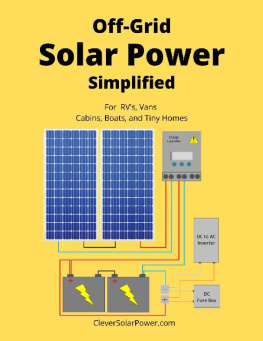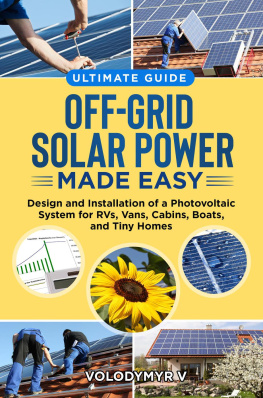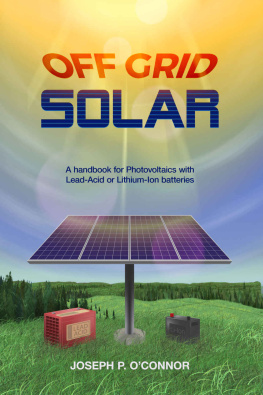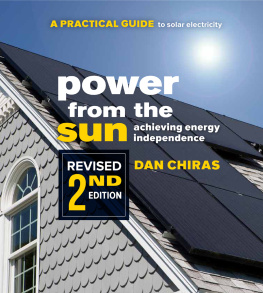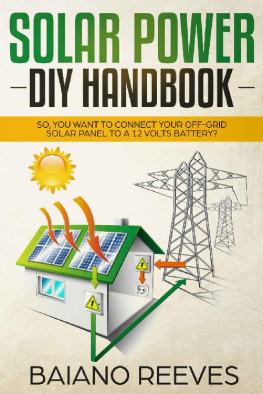Off-Grid Solar Power Simplified
~
For RVs, Vans, Cabins, Boats, and Tiny Homes
Copyright 2020 by cleversolarpower.com - All rights reserved.
The transmission, duplication, or reproduction of any of the following work, including specific information, will be considered an illegal act irrespective of if it is done electronically or in print. This extends to creating a secondary or tertiary copy of the work or a recorded copy and is only allowed with an expressed written consent from the Publisher. All additional rights reserved.
Additionally, the information in the following pages is intended only for informational purposes and should thus be thought of as universal. As befitting its nature, it is presented without assurance regarding its prolonged validity or interim quality. Trademarks that are mentioned are done without written consent and can in no way be considered an endorsement from the trademark holder.
Introduction
Among available renewable energy sources, solar photovoltaic (SPV) is the most practical, distributable, and mature of them.
With a demanding increase in grid-tied and off-grid PV systems, the need to provide a simple but yet technical reference for the design of these power sources is always increasing. A wide range of available options exist to size an off-grid solar power system and will depend upon the specific power and energy requirements of the user.
This book focuses on the pragmatic approach to design and install an off-grid solar power system with all the specific components, steps, and recommendations that you will need to size your PV system and install it in your Rv, van, cabin, boat, or tiny home.
Some of the important content you will find in this book refers to basic electrical principles, solar panel types, tools, and equipment used for the installation, inverter and battery types, charge controller specs, and types of PV systems.
Moreover, we will also discuss safety and precaution rules to install an off-grid system, steps to size, and wire up your solar array, as well as examples to give you a better idea about the schematics of a PV system.
The content in this guidebook will be explained in simple terms to give a clear idea to both technical and non-technical readers about all the requirements of an off-grid PV system.
This information will allow you to install your PV system without the need to require an electrician or a solar designer to complete the task.
Electrical Units
Energy can be described in many ways, but basically, energy is referred to as the capacity of developing a specific work. Energy is presented in many ways in nature, and one of them is electricity, which can be described as the capacity to establish electrical work.
To understand how electricity works, some important concepts must be addressed.
First, you must understand that an electrical circuit can be described as the interconnection of electrical components where at least three basic elements will exist:
- Power source
- Conductor
- Load

Basic electrical circuit
The power source is referred to as the element that produces or stores electricity (a battery, a generator, or a solar panel).
The conductor is simply the element through which electricity flows.
The load is the element that receives electricity from performing some sort of work (a lamp generates light, a motor provides motion, and an electrical resistor generates heat).
Now, in order to understand the concepts that will be explained throughout this book, we need to describe some electrical terms first.
Voltage
Electricity is generated by the movement of electrical charges (electrons). In order to move an electron from one point to the other, it is necessary to perform electrical work.
This work is performed by an electromotive force (EMF) or voltage, which is generated by the power source. Voltage can be understood as the pressure required to move the electrons from one point (A) to a second point (B) within an electrical circuit. The greater the voltage, the greater the flow of electrons through an electrical conductor.
This movement is generated from the highest electrical potential point (A) to the lower electrical potential point (B), and voltage is referred to as the electrical potential difference between these two points.
Voltage is measured in Volts (V).
Current
The second important concept is the electrical current.
The electrical current can simply be understood as the intensity of the flow of electrons per second through a conductor.
This element is measured in Amps (A).
Resistance
The resistance is referred to the opposition of a specific material to the flow of electrical current. In other words, the resistance provides a reference of how easy or hard it is for the electrons to flow through any material (steel, aluminum, copper, etc.).
Every electrical load or conductor has an internal resistance, which is typically measured in ohms (). For example, wood has a higher electrical resistance than copper.
Power
Power is one of the most important variables in electricity as it represents the combination of voltage and current in an electrical circuit.
In order for an electrical load to perform any type of work (illumination, motion, heat), this element demands an instantaneous equivalent work source, which is provided by power. Power acts as a reference to the rate at which electricity is delivered (power source) or consumed (load) and is the product between voltage and current. The unit of power is Watt (W).
Electrical Energy
As we mentioned before, power is referred to as the instantaneous rate at which electricity is provided or consumed. When we refer to energy, we are evaluating how electricity is being delivered or consumed over time.
In other words, electrical energy can be described as the power generated or consumed over time.
As a general convention, electrical energy is typically expressed in watt-hour (Wh), which represents the consumption of a specific number of watts in a single hour. This unit will generally be used to account for energy consumption of electrical loads in an off-grid solar power system.
Also, when consumption is bigger, it is generally expressed in kilowatt-hours (kWh), which is referred to as the consumption of 1,000 watts of power in a single hour. This unit will generally be used to account for electricity generation or consumption of an entire solar power system. You will be already familiar with the term Kilo Watt-hours, as it is listed on your electricity bill.
Amp-hour
Energy can also be expressed as consumption of the amount of current in a single hour and is referred to as amp-hour (Ah).
Amp-hours is used to describe the amount of energy a battery can store. The battery of a typical smartphone has a capacity of 3 Amp-hours or 3,000milli Amp-hours.
Ah is mainly used in off-grid solar power systems to indicate the amount of energy a battery can store.
Energy Measuring Equipment
Digital Meter
The digital meter (regularly known as a digital multimeter) is a test tool that is used to measure at least three variables:
- Voltage (AC and DC)
- Electrical current (DC)
- Resistance
A digital meter combines the capabilities of three tools into one: an analog voltmeter (measures volts), an analog ammeter (measures amps), and an analog ohmmeter (measures resistance).

